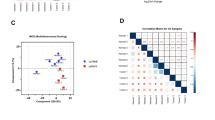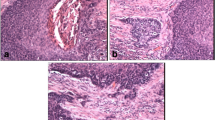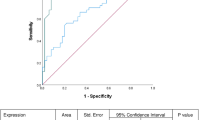Abstract
Deregulation of microRNAs (miRNAs) is essential to tumor development, and serum miRNA profiles have been reported in several cancers. However, the serum miRNA profile in oral squamous cell carcinoma (OSCC) remained unclear. The present study aimed to explore abnormal miRNA profile in sera samples from OSCC patients and the association of miR-483-5p with patient prognosis. Microarray analysis was performed in sera from OSCC patients versus healthy controls. miR-483-5p expression was measured by reverse transcription (RT)-PCR and correlated to clinicopathological characteristics of OSCC patients. The prognostic significance was then evaluated with a Kaplan–Meier curve and log-rank tests, using a Cox proportional hazard model. According to microRNA array, 16 miRNAs were upregulated and 10 were downregulated in OSCC patient sera. miR-483-5p expression was significantly increased in OSCC patients (3.23-fold, p < 0.01), and this was significantly correlated with tumor nodal metastasis (TNM) stage and lymph nodal metastases (p < 0.01, p < 0.01). For predicting OSCC, receiver operating characteristic (ROC)/area under the curve (AUC) analysis confirmed a AUC of 0.85 (sensitivity of 0.853 and specificity of 0.746). OSCC patients with high serum miR-483-5p had lower survival than those with low expression, and multivariate analyses for overall survival revealed that high serum miR-483-5p expression was an independent prognostic factor for OSCC (HR = 2.32, 95 %CI 1.20–4.48). miR-483-5p expression increased in OSCC patient sera, and this may be a novel diagnostic and prognostic biomarker for OSCC.





Similar content being viewed by others
References
Jemal A, Siegel R, Ward E, Hao Y, Xu J, et al. Cancer statistics, 2009. CA Cancer J Clin. 2009;59:225–49.
Warnakulasuriya S. Squamous cell carcinoma and precursor lesions: prevention. Periodontol. 2011;2000(57):38–50.
Gupta K, Metgud R. Evidences suggesting involvement of viruses in oral squamous cell carcinoma. Patholog Res Int. 2013;2013:642496.
Tsantoulis PK, Kastrinakis NG, Tourvas AD, Laskaris G, Gorgoulis VG. Advances in the biology of oral cancer. Oral Oncol. 2007;43:523–34.
Ambros V. The functions of animal microRNAs. Nature. 2004;431:350–5.
Bartel DP. MicroRNAs: target recognition and regulatory functions. Cell. 2009;136:215–33.
Livak KJ, Schmittgen TD. Analysis of relative gene expression data using real-time quantitative PCR and the 2(−Delta Delta C(T)) Method. Methods. 2001;25:402–8.
Murugan AK, Munirajan AK, Tsuchida N. Ras oncogenes in oral cancer: the past 20 years. Oral Oncol. 2012;48:383–92.
Ries J, Vairaktaris E, Kintopp R, Baran C, Neukam FW, et al. Alterations in miRNA expression patterns in whole blood of OSCC patients. In Vivo. 2014;28:851–61.
Ries J, Vairaktaris E, Agaimy A, Kintopp R, Baran C, et al. miR-186, miR-3651 and miR-494: potential biomarkers for oral squamous cell carcinoma extracted from whole blood. Oncol Rep. 2014;31:1429–36.
Liu CJ, Lin SC, Yang CC, Cheng HW, Chang KW. Exploiting salivary miR-31 as a clinical biomarker of oral squamous cell carcinoma. Head Neck. 2012;34:219–24.
Qu X, Zhao M, Wu S, Yu W, Xu J, et al. Circulating microRNA 483-5p as a novel biomarker for diagnosis survival prediction in multiple myeloma. Med Oncol. 2014;31:219.
Zheng XH, Cui C, Ruan HL, Xue WQ, Zhang SD, et al. Plasma microRNA profiling in nasopharyngeal carcinoma patients reveals miR-548q and miR-483-5p as potential biomarkers. Chin J Cancer. 2014;33:330–8.
Yoon AJ, Wang S, Shen J, Robine N, Philipone E, et al. Prognostic value of miR-375 and miR-214-3p in early stage oral squamous cell carcinoma. Am J Transl Res. 2014;6:580–92.
Turchinovich A, Weiz L, Langheinz A, Burwinkel B. Characterization of extracellular circulating microRNA. Nucleic Acids Res. 2011;39:7223–33.
Acknowledgments
We thank LetPub (www.letpub.com) for its linguistic assistance during the preparation of this manuscript.
Conflicts of interest
None
Author information
Authors and Affiliations
Corresponding author
Additional information
Huanxi Xu and Yuqi Yang contributed equally to this work.
Rights and permissions
About this article
Cite this article
Xu, H., Yang, Y., Zhao, H. et al. Serum miR-483-5p: a novel diagnostic and prognostic biomarker for patients with oral squamous cell carcinoma. Tumor Biol. 37, 447–453 (2016). https://doi.org/10.1007/s13277-015-3514-z
Received:
Accepted:
Published:
Issue Date:
DOI: https://doi.org/10.1007/s13277-015-3514-z




